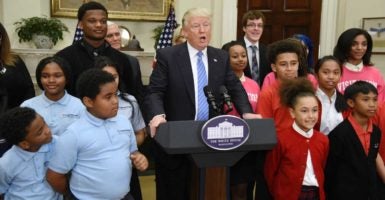The Trump administration’s full budget for education for fiscal year 2018 would make some long-overdue cuts at the Department of Education.
The proposal targets reductions in spending totaling $9 billion—a 13 percent cut in the agency’s current $68 billion annual budget. That type of reduction signals a serious commitment to reducing federal intervention in education—a necessary condition to make space for a restoration of state and local control.
Program Eliminations and Spending Reductions
The budget proposal includes actual reductions in spending and program count. As Andrew Ujifusa at Education Week reported, it would be the largest single-year percentage cut in the department’s discretionary budget since President Ronald Reagan’s 1983 budget proposal.
In recognition that many federal education programs are better supported—and appropriately supported—by state and local as well as private funds, the budget would eliminate several competitive grant programs. It would cut the Striving Readers, Teacher Quality Partnership, Impact Aid Support Payments for Federal Property, and International Education programs. It would also eliminate some larger programs that are overdue for re-examination.
- Eliminates 21st Century Community Learning Centers. The budget would eliminate the 21st Century Community Learning Centers Program, which appropriates federal taxpayer funding to after-school programs during non-school hours.
Not only is this not an appropriate activity in which the federal government should engage, but there is no evidence that the program, started in 1994, is improving outcomes for participants.
Rigorous scientific evaluations of the program have found that it failed to improve homework outcomes for participants and had harmful impacts on academic and behavioral outcomes.
As my colleague David Muhlhausen has written, “advocates of evidence-based policy should applaud the president’s fiscally responsible decision” to eliminate this ineffective and inappropriate federal program.
- Zeroes Out Title IV funding. The budget would eliminate a new program created under the Every Student Succeeds Act, the successor to No Child Left Behind.
The program, known as the Student Support and Academic Enrichment grant, authorized at up to $1.6 billion (appropriated at $400 million last year), is designed to bolster technology and student health efforts, among other purposes. The budget correctly identifies new programs added under the Every Student Succeeds Act as growing, rather than reducing, federal intervention in education, and eliminates funding.
- Eliminates Title IIA grants. The budget also eliminates Title IIA of the Every Student Succeeds Act—the Supporting Effective Instruction program, which appropriates some 2.4 billion in federal taxpayer dollars to teacher professional development programs and for class size reduction.
As with the other programs this budget zeroes out funding for, teacher professional development programs are not the purview of the federal government. And evidence suggests there is little return on investment from teacher professional development programs or class size reduction as a means of improving student academic achievement.
Federal Funding for New School Choice Programs
The budget would establish two new federal forays into funding school choice—an effort that should be reserved for state and local governments.
- Additional money for Title I. The budget would establish a new grant program under Title I totaling $1 billion, with the goal of allowing students to take this new funding to public schools of choice.
Title I is the largest federal K-12 education program, and is designed to provide additional federal funds to low-income school districts. Spending on Title I has grown significantly in recent years.
The additional $1 billion Furthering Options for Children to Unlock Success (FOCUS) program would take Title I spending up to nearly $16 billion ($15.9 billion), up from $12.8 billion just a decade ago. Instead of giving states an option on Title I portability within the existing confines and spending of the program (a worthwhile policy goal), enabling students to use funds at a school of choice, this appears to be a new sub-program established under Title I.
Launching yet another new program at the federal level moves in the wrong direction, growing—rather than reducing—federal intervention in K-12 education.
- New funding for research grants and voucher programs. The budget also increases spending under the Education Innovation and Research Fund, from $100 million to $370 million, in order to study the impact of school choice, and potentially to expand school choice.
The federal government is not the appropriate vehicle for studying state-based school choice programs. Scholars across the country conduct high-quality, rigorous assessments of state-based school choice programs, and those individuals and teams should remain at the forefront of that work.
The $370 million would also be available to advance private school of choice. Although choice is worthwhile policy, it should be done at the state and local level, not through new federal spending via a program designed for research and evaluation.
The Trump administration has outlined a budget that rightly downsizes spending and program count at the Department of Education—a long-overdue step that can pave the way for a restoration of state and local control of education.
And in that spirit, school choice should also remain a state and local endeavor, save for federal spending related to military-connected children, children attending Bureau of Indian Affairs Schools, and children residing in the District of Columbia.
On balance, reductions in spending and program count show an education budget that moves in the right direction.





























